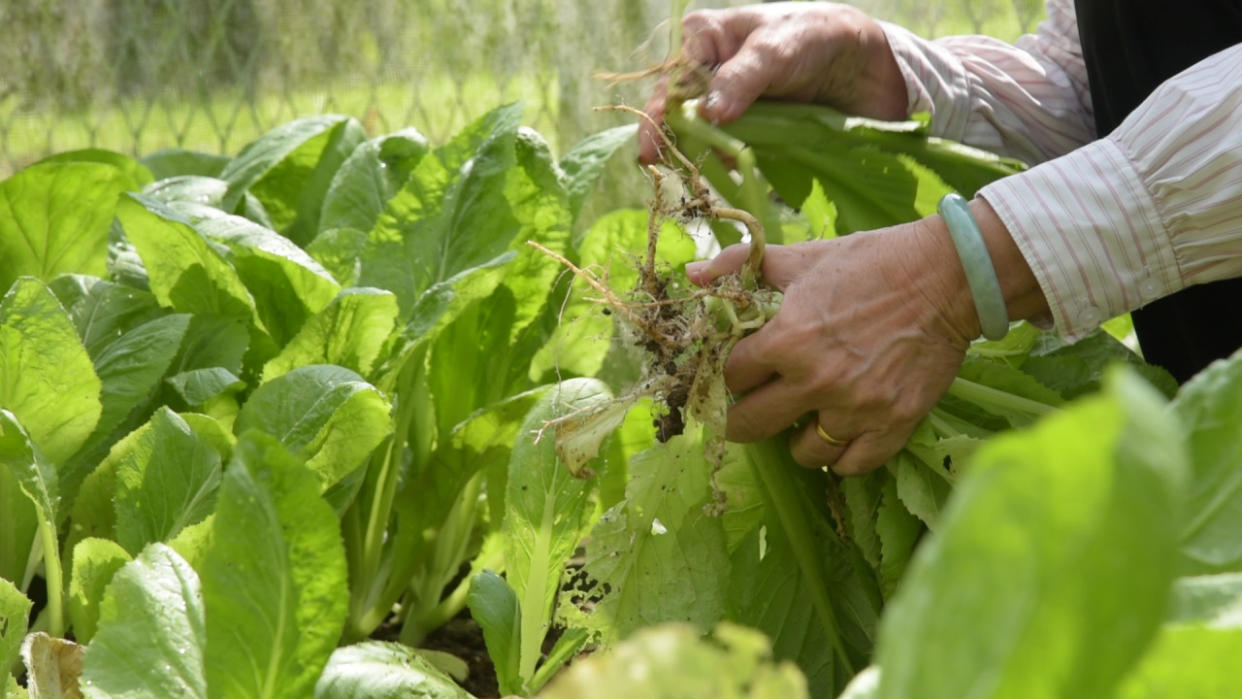A labour of love: Inside the community gardens of Bukit Panjang

A Bukit Panjang resident tends to her crops. Photo: Andre He/Yahoo Singapore
In the heart of Bukit Panjang lies a garden where juicy winter melons, pumpkins, lady’s fingers and white bitter melons grow, and where residents can feast on some of the freshest vegetables in Singapore.
Sitting on the top of a hill in Bukit Panjang N2 Park is one of 11 community gardens in the district that specialises in edibles and medicinal herbs. At 1,570 sq m, it’s the largest allotment-style garden – where each resident is assigned a row to plant his or her crops – in Singapore. Bukit Panjang also ranks among the districts with the most community gardens in Singapore.
The gardens are tended to by some 280 residents, many of them retirees. More than a few were once farmers in Lim Chu Kang, Choa Chu Kang and Woodlands who were resettled in Bukit Panjang in the 1980s. One of them is retiree Ang Ah Tua, 88, who raised chickens and pigs with her family in Mandai more than four decades ago.
The grandmother of 16, who spends two to three hours a day tending to her crops such as long beans, kang kong (water spinach) and sweet potato leaves, said in Mandarin, “When you plant things and they bloom, you feel good because all your hard work is rewarded.”
Sowing the seeds
Video by Andre He
The community gardens scheme is wildly popular: There will be six more in the district by next year, with a waiting list of dozens of residents. After the Holland-Bukit Panjang Town Council does the initial set up, it is left to the respective Residents’ Committees to disburse the slots to interested residents. Each individual is restricted to one row in one garden in his respective zone. The rows are one metre wide, and five to 10 metres in length.
It was not always an organised effort. Bukit Panjang Member of Parliament Dr Teo Ho Pin, recalled that there were only two gardens back in 1996, which were ad-hoc in nature. More gardens were gradually constructed following requests from residents.
“The gardens are self managed by the residents, and the sense of ownership and sharing among them is strong,” said Teo.
According to Holland-Bukit Panjang Town Council assistant general manager Lawrence Toh, the gardens are financed under the Housing Development Boards’s Neighbourhood Renewal Programme, and cost between $5,000 and $30,000 each.
While water points are provided, individual residents bear the cost of seeds, fertiliser, tools and whatever else they may need. Residents said that a bag of fertiliser, which can last for months, costs $4-$5. Tools like shears and gloves also typically cost a few dollars.
But the hard work is all worth it. Housewife Agnes Goh, 53, showed Yahoo Singapore enormous heads of cabbage, grown from seeds that she bought in Korea. Asked what distinguishes the vegetables grown in the gardens, Goh said, “Vegetables in supermarkets are older and more bitter. Our vegetables are sweeter and softer, and fresher too. There is a lot of satisfaction when you eat it, especially as it has no pesticide.”
The monkeys in the nearby forest obviously agree: They have been known to climb the garden fence in search of food, said Residents’ Committee chairman Lim Yong Moi.
A nationwide effort

Lady’s fingers. Photo: Andre He/Yahoo Singapore
There are about 1,000 community gardens nationwide which come under the National Parks Board’s (NParks) Community In Bloom programme. Launched in 2005, it aims to nurture a gardening culture among Singaporeans and build community bonds. NParks helps by providing starter kits and experts to give advice and conduct workshops and talks about gardening.
NParks even runs a competition for residents to show off their produce - the Community Garden Edibles Competition gives gardeners the opportunity to show off the longest or heaviest fruit or vegetable they have grown, with cash prizes for top entries.
Residents like Er Ah Hui, 61, find much joy in the community of gardening residents. “Gardening is also a form of exercise, and we always chat and share our harvests. I have made a lot of friends here.”
Gesturing to the fat winter melons hanging in her row, she added with a laugh, “I can take the winter melon home and make soup with it, or we can cut it and share it with everyone here.”


